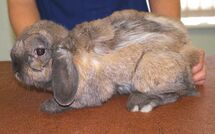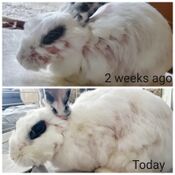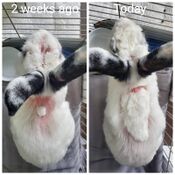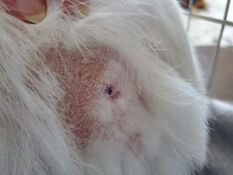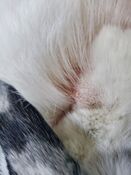Sebaceous adenitis
Sebaceous adenitis is an uncommon skin condition in rabbits. It is characterized by flaky dry skin that forms brittle plaques and also by patchy hair loss.
Symptoms
Typically, rabbits with idiopathic sebaceous adenitis (ISA) present with flaky skin and patchy hair loss around the head and shoulders. This is often, but not always, progressive.
In some cases these rabbits show neurological involvement and develop an unusual gait that suggests stiffening of joints (especially the hind end), but may result from muscular ataxia.
The condition is sometimes merely uncomfortable for rabbits in early stages, but can be quite painful as the disease progresses.
Diagnosis
Alternative diagnoses might include ringworm (Tinea spp.) and other fungal skin infections, bacterial skin infections, ear mites (Psoroptes cuniculi) and other arthropod infestations. Usually these can be ruled out with skin scrapings and applications of appropriate remedies.
Thymoma and leukemia are also known to cause symptoms consistent with sebaceous adenitis. Thymoma can be ruled out by a simple thoracic radiograph.
The hallmark of idiopathic sebaceous adenitis (ISA) is histological. A skin biopsy would show sebaceous glands invaded by lymphocytes (if they have not been destroyed already), hyperkeratosis and perifollicular lymphocytic folliculitis in the absence of tumor or cancer.
Causes
ISA is thought to be caused by an accumulation of a metabolic intermediate caused by a defect in lipid metabolism in the sebaceous glands and autoimmune response to that accumulated lipid intermediate.
The causes are not known, though it is plausible that both environmental and genetic causes play a role in the disease. The disease may disproportionately affect female rabbits, though the information supporting this is largely anecdotal.
Treatment
The prognosis is generally grim though some success has been seen treating rabbits with cyclosporin A in a medium-chain triglyceride vehicle (Mygliol) orally combined with topical treatment with phosphosphingosine (regular baths and spot treatments).
Refined coconut oil is thought to be a topical palliative in lieu of pharmaceutical approach, though many phosphosphingosine sprays, shampoos and conditioners are also available without a prescription.
Topical treatments (combination of spray, shampoo and conditioner) usually cost about $60 for a 2 month supply while cyclosporin and Mygliol is much more expensive at about $150 for a 30 day supply.
Extra resources
- Chaowaphan Yinharnmingmongkol, DVM. (2016). The Use of Cyclosporine and PCSO-524® in the Treatment of Alopecia and Dermatitis due to Sebaceous Adenitis in Rabbits
- Kovalik et al. (2012). Successful treatment of idiopathic sebaceous adenitis in a lionhead rabbit [PDF]
- Annette Jassies-van der Lee et al. (2008). Successful treatment of sebaceous adenitis in a rabbit with ciclosporin and triglycerides [PDF]
Experiences
GeorgieR. posted about Sansa and her hair loss mystery on November 12, 2022:
A couple months ago she developed very flaky skin and started losing some hair on her back. We started with a treatment of revolution but the following week there was a massive amount of hair loss all over her body which no longer seemed consistent with mites.
She had a skin biopsy last week (you can see the stitch where they took the sample on her back) and just got results today that it is sebaceous adenitis.
...
Here are some pictures showing how her hair still continues to grow back but the skin is still very flaky underneath so it'll likely fall out again soon....
- Nicole A Heinrich et al. (2020). Disparate histopathology of sebaceous adenitis in a rabbit
- Opalmoon. (2018). White crust taking over my bun
- u/kinenchen. (2017). Idiopathic Sebaceous Adenitis (ISA) in adult domesticated bunnies - part 1, part 2.
- longhairmike. (2011). sebaceous adenitis, Buki’s last night (Graphic)
- Stardust. (2010). Sebaceous Adenitis
- Lara Walker. (2010). Isabelle suffering from sebaceous adenitis possibly related to a thymoma (Graphic)
- Koenraad Florizoone. (2005). Thymoma-associated exfoliative dermatitis in a rabbit (RIP)
Further reading
- Esther van Praag, Ph.D. Sebaceous adenitis in rabbits
- Vetlexicon. Sebaceous adenitis


